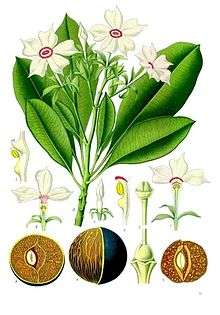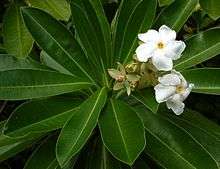Cerbera odollam
Cerbera odollam is a dicotyledonous angiosperm, a plant species in the family Apocynaceae and commonly known as the suicide tree, pong-pong, mintolla, and othalam. It bears a fruit known as othalanga (Malayalam: ഒതളങ്ങ) that yields a potent poison that has been used for suicide and murder. It is a species native to India and other parts of southern Asia, growing preferentially in coastal salt swamps and in marshy areas but also grown as a hedge plant between home compounds.
| Cerbera odollam | |
|---|---|
 | |
| Leaves, flowers and seeds of C. odollam From Koehler's Medicinal-Plants 1887 | |
| Scientific classification | |
| Kingdom: | Plantae |
| Clade: | Tracheophytes |
| Clade: | Angiosperms |
| Clade: | Eudicots |
| Clade: | Asterids |
| Order: | Gentianales |
| Family: | Apocynaceae |
| Genus: | Cerbera |
| Species: | C. odollam |
| Binomial name | |
| Cerbera odollam | |
Common names
Cerbera odollam is known by a number of vernacular names, depending on the region. These include othalam (ഒതളം) in the Malayalam language used in Kerala, India; kattu arali (காட்டரளி) in the adjacent state of Tamil Nadu; famentana, kisopo, samanta or tangena in Madagascar; and pong-pong, buta-buta, bintaro or nyan in Southeast Asia.[1]
Description
Cerbera odollam bears a close resemblance to oleander, another highly toxic plant from the same family. Its branchlets are whorled about the trunk, and its leaves are terminally crowded, with tapering bases, acuminate apices, and entire margins. The plant as a whole yields a milky, white latex.
Its fruit, when still green, looks like a small mango, with a green fibrous shell enclosing an ovoid kernel measuring approximately 2 cm × 1.5 cm and consisting of two cross-matching white fleshy halves. On exposure to air, the white kernel turns violet, then dark grey, and ultimately brown, or black.
Toxicity

The kernels of C. odollam contain cerberin, a digoxin-type cardenolide and cardiac glycoside toxin that blocks the calcium ion channels in heart muscle, causing disruption of the heart beat, most often fatally. The most common symptom of toxicity in humans was noted to be vomiting. Electrocardiographic abnormalities were noted to be common, the most common being sinus bradycardia. Around half of the patients develops thrombocytopenia. Temporary cardiac pacing has been used in the management, apart from other supportive measures.[2] The difficulty in detecting cerberin in autopsies and the ability of strong spices to mask its taste makes it an agent of homicide and suicide in India; there were more than 500 cases of fatal Cerbera poisoning between 1989 and 1999 in the southwest Indian state of Kerala.[1][3]
A fatal dose of the poison is contained in one kernel, leading to death within 1–2 days.
Common symptoms include:
- burning sensation in mouth
- violent vomiting
- irregular respiration
- headache
- irregular heartbeat
- coma and eventual death
Uses
The fruits are used for manufacturing bioinsecticides and deodorants.[4][5]
Investigations have also been made into the feasibility of using the seeds as a feedstock in the production of biodiesel.[6]
See also
References
| Wikimedia Commons has media related to Cerbera odollam. |
- Gaillard Y, Krishnamoorthy A, Bevalot F., 2004, "Cerbera odollam: a 'suicide tree' and cause of death in the state of Kerala, India," J. Ethnopharmacol. 95(2-3):123-126.
- Menon, M Suraj (2016). "Clinical profile and management of poisoning with suicide tree: An observational study". Heart Views. 17 (4): 136–139. doi:10.4103/1995-705X.201783. PMC 5363088. PMID 28400936 – via Wolters Kluwer - Medknow.
- James Randerson, 2004, "'Suicide tree' toxin is 'perfect' murder weapon" [commentary on Gaillard, et al., 2004, op. cit.], New Scientist (online), November 26, 2004, see , accessed 18 June 2015.
- P.I. Rajeev, 2007, "‘Suicide fruit’ now a rich harvest?," The Indian Express (online), February 3, 2007, see , accessed 18 June 2015.
- Sarah Kaplan, 2015, "Morning Mix: The brutal harvest of India’s ‘suicide tree’," The Washington Post (online), May 8, 2015, see , accessed 18 June 2015.
- Kansedo, Jibrail; Lee, Keat Teong; Bhatia, Subhash (2009). "Cerbera odollam (sea mango) oil as a promising non-edible feedstock for biodiesel production". Fuel. 88 (6): 1148–1150. doi:10.1016/j.fuel.2008.12.004.